

Issue No. 261 | October 10, 2025 | Read Online
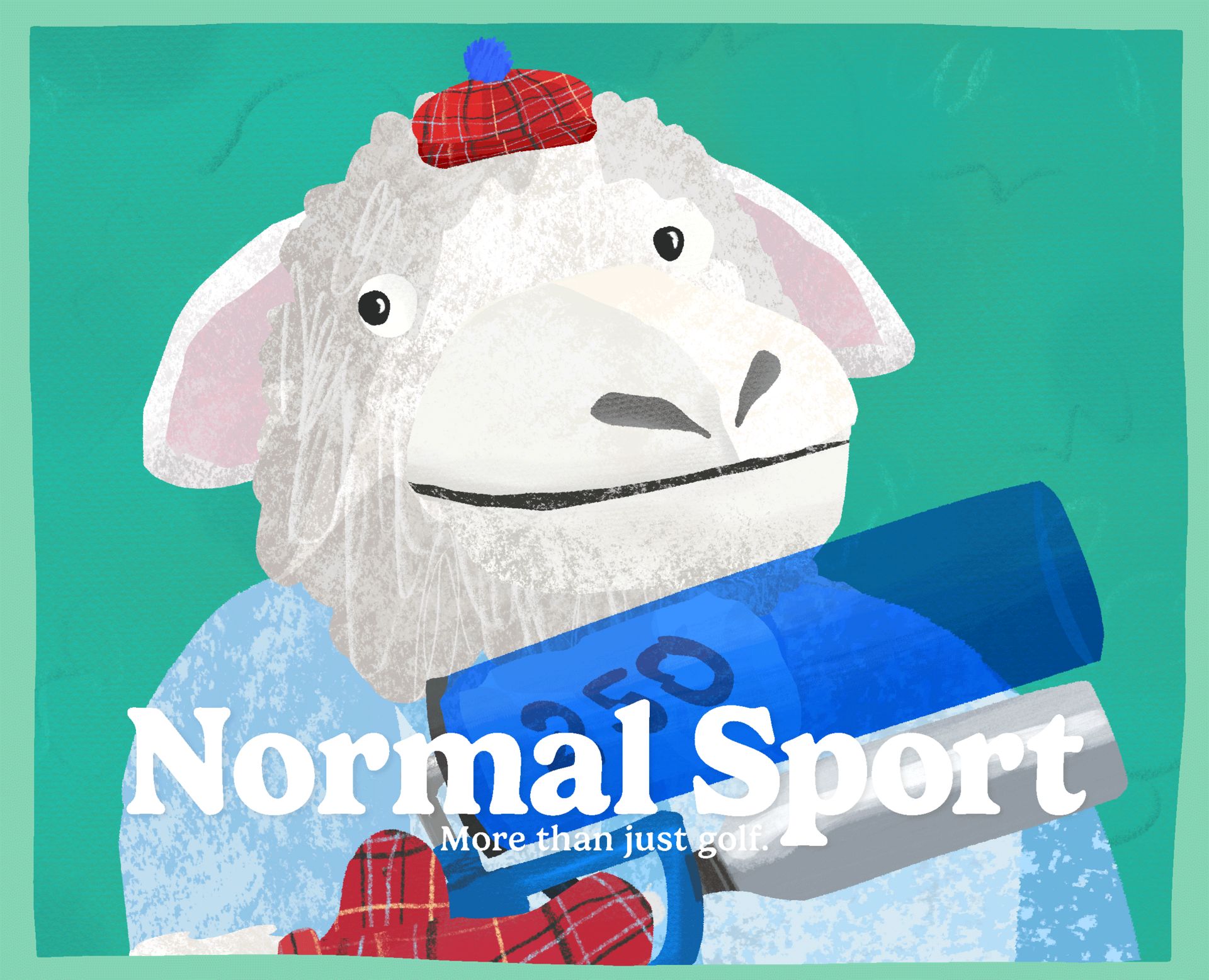
Greetings!
Last week marked one year of Normal Sport as a full-time business. We haven’t run out of money (yet!), and we certainly haven’t run out of things to say and illustrate.
I have been reflecting not only on that first year but also on passing the 250 newsletter mark (roughly 500,000+ words since February 2023) and had a few thoughts I wanted to share with all of you about the journey.
Things I’ve loved. What I’ve dreaded. Some extraordinary moments. A bit of what I’ve learned.
This is work, I guess, but never has my life and my work been so intertwined. That can be a good thing — it has been an amazing thing for me — but it can also be a detrimental thing if I let it take over my mind and my heart and begin ignoring my kids because “I’m sorry, honey, but I just cannot stop thinking about the odd and even holes at Bethpage.”
But we’ll get to all that.
First!
Thank you to Seed Golf for sponsoring today’s newsletter. Seed has been with us since basically Day 1 of running this business full time, which has been exciting. Over that time we’ve gotten to know Seed founder Dean and learned from him how to run an authentic business in the golf world, which has been so helpful for us.
You don’t need to take it from me that you should check them out, either (although you should) because I got this email from a reader this week about his experience with Seed Golf.
Last thing, I ordered a box of Seed balls and really like them, so will for sure be ordering some more. Thanks again and I look forward to seeing what comes next for Normal Sport.
Andy H.
Thank you to Seed Golf for their partnership. You can get 20 percent off your next order by using this link.
OK, now onto the news.

1. To be completely honest, I’ve always hated the term “newsletter.” In the same way the word “golf” connotes a thing that is old and fussy and stodgy for many people, I think the word “newsletter” does the same.
Newsletters should be called “journal entries” or “longer tweets” or something like that.
I’ll never forget reading this from the godfather of paid newsletters, Ben Thompson of Stratechery fame. It is an idea that is very much my wheelhouse.
Stratechery has become in many respects a journal of my own attempts to understand technology specifically and the way in which it is changing every aspect of society broadly.
And, it turns, out, the business model is even better: instead of taking on the risk of writing a book with the hope of one-time payment from customers at the end, Stratechery subscribers fund that intellectual exploration directly and on an ongoing basis; all they ask is that I send them my journals of said exploration every day in email form.
Stratechery
That is almost exactly how I view Normal Sport: A journal of my own attempts to understand golf specifically and what it says about both us as individuals and the world more broadly.
2. I have perhaps mentioned this before, but I thought when I got into sportswriting, I would find the “ends of the parameters” (as Bryson noted in his pre-Masters press conference earlier this year). Instead, the opposite has happened.
I have been doing this for 13 years now, and I’ve never felt like I’ve had more to talk about. The rabbit hole, as it turns out, just keeps on going and going and going and I find the exploration of it to be endlessly fascinating. All of it. The data, the emotional nature of this sport, the history of it. I’m intrigued by it all.
I do not know why this is the case, but I am extremely glad that it is unquestionably the case.
[Jason here] “Ends of parameters” feels like a good place to jump in with my illustration notes. Every week, for the past year and a half, I dive into the illustrators pit totally unsure what will come up. Sometimes it goes well, often it goes sideways, but something always goes into the newsletter.
That rush to publish is the fun and the challenge of it. Just like how you can’t have an exhibition without art, you can’t have an illustrated newsletter without illustrations.
I like how these time lapses capture the searching for an image. They’re all made in a flurry, and only once they’re in the world am I able to reflect and think about what works, what doesn’t work, what can be reworked later.
Like how this illustration of hypnotized Chris Gotterup turned into the rowdy Bethpage crowd VR training for team Europe.
I hope you like a peek into how the illustration sausage is made.
3. [Kyle back] The flip side of this is that I have learned that I am a bad self-editor. I tend to write 2,200 words when 600 are needed.
The (perhaps apocryphal) Blaise Pascal quote often comes to my mind.
If I had more time, I would have written a shorter letter.
Blaise Pascal
I am working — laboring! — to edit down, to get tighter with what I’m saying. And while I find that I rarely speak for an inordinate amount of time, there is really no limit to how much I can (and want to) type, research, think and type some more. The good side to err on, I suppose, but a shortcoming nonetheless.
4. We are moving (back) toward campfires.
I have written about this a bit, but I was rattled by a conversation I had earlier this year with another writer who insisted that nobody is reading anymore and that society is moving toward a modern version of what it has been forever, which is just people telling stories around a campfire (in other words, podcasts).
This is part of the reason we recently launched our show, which I have been excited about and was even more confident about after reading this data in our 2025 survey.
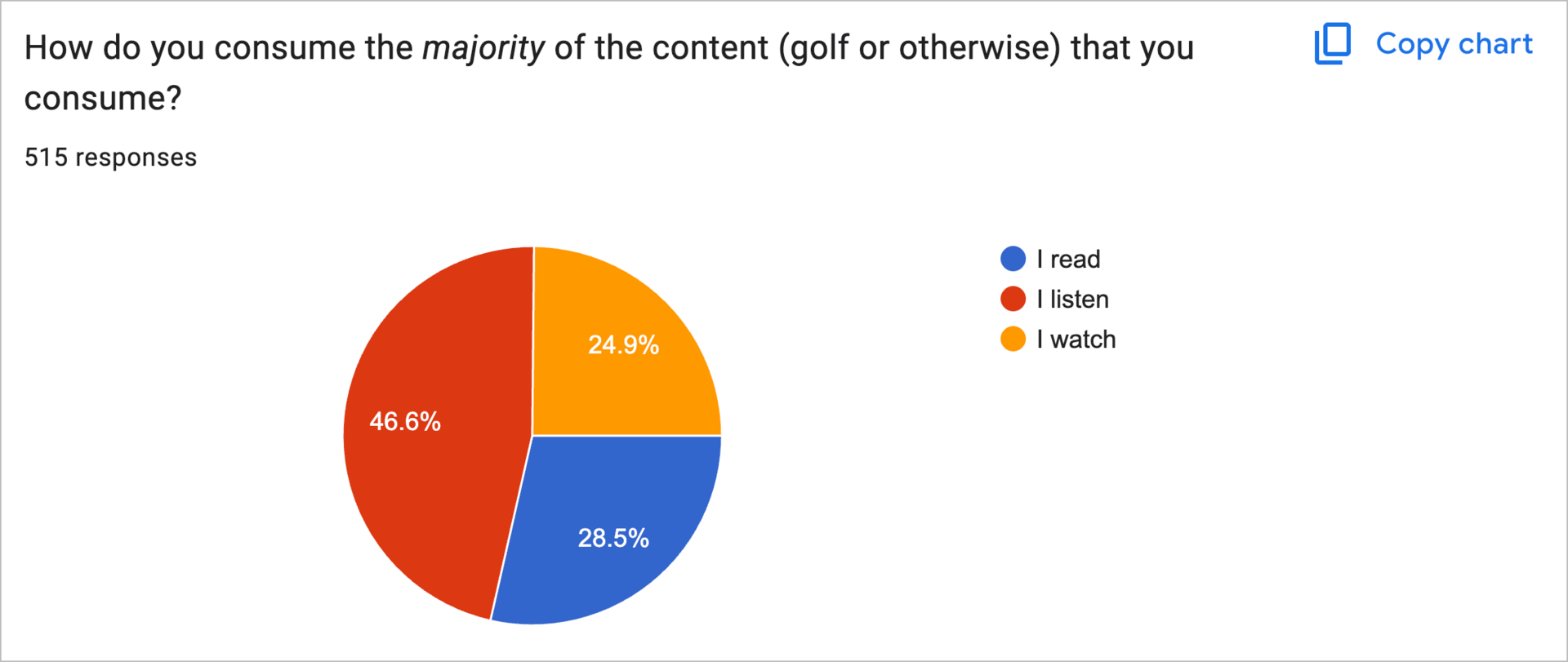
That is pretty staggering to me — a newsletter writer! — even if I probably find myself agreeing with it in my own life with the way I interact with other media.
5. Nontraditional can work. My friend Sean Zak asked me to guest lecture on newsletters for his sports media class at Marquette this fall. In light of that, I was thinking about how no teacher in their right mind would advise someone to write or communicate the way I write and communicate.
It would not get me a job at a newspaper for most of the modern existence of newspapers. I would probably be laughed out of any 101-level journalism class.
I make jokes about reptile skull golf trophies. It’s all actually quite stupid.
But I find this to be a feature rather than a bug. I grew up in the Bill Simmons world where observing and theorizing were often (not always, but often) more intriguing than dull reports about why the manager pulled his starter at the end of the 5th.
And I think my style is probably as nontraditional as my methodology. I write like I talk. Full stop. Again, historically-speaking, no professor would approve this, but for some reason, it seems to … work?
Here’s Joan Didion on writing.
To shift the structure of a sentence alters the meaning of that sentence, as definitely and inflexibly as the position of a camera alters the meaning of the object photographed ...
The arrangement of the words matters, and the arrangement you want can be found in the picture in your mind ... The picture tells you how to arrange the words and the arrangement of the words tells you, or tells me, what's going on in the picture.
Joan Didion
This is how I put this newsletter together!
Also, me reading Joan Didion talking about hanging pictures in your mind.

6. [Jason here] My version of this is making portraits for our Q&A series, which was one of the most fun and challenging illustration exercises in the past year.
Fun to get to know characters in the golf world and challenging to do their characters justice in a portrait.
Here’s how I introduced that experience in Jeff Marsh’s ’GOLF is art’ 3.
Nobody wants to see a botched Ronaldo sculpture of their face for the sake of art. That’s a lot of pressure. Photography does a pretty good job of capturing reality, so instead, in my illustrations, I loosely loosely for the visual essence of the subject’s character and work. Easier said than done.
My process starts with a “this sucks”, then gets going when I think of Chet Baker’s line “let’s get lost”, and finally races ahead when the face starts to emerge like the “there you are” dinner scene in Hook when Robin Williams becomes Peter Pan.
Me - (GOLF is art 3)
7. [Kyle back] Here’s a weird one. I feel less exposed and like my career is more stable than I did two years ago when I worked for one of the biggest media companies in the world. Perhaps I am overly desirous of control. Or perhaps the ability to direct one’s future without it being directed by outside forces actually is more stable.
This is not to say that it has been a financial windfall. I am making half of what I used to make, but the two paths I see (old at CBS and new at Normal Sport) could not look more different. I thought this could be the case, but I wasn’t sure it would be.
I am delighted that it is.
8. To go along with this, I have realized that I am quite content if Normal Sport never becomes a $10 million business.
This might sound silly, but I had a conversation recently with Ethan Strauss on his show about how I either feel more content or less ambitious than before.
I simply want to make a baseline level of money for my family and to get to go create and do wonderful work alongside sponsors who help support it and a great audience who loves receiving it. Again, this may sound like a “duh, that’s just business” thing to you, but I did wonder if my ambition for more and bigger and grander would overtake my contentedness to do the thing that I have grown to love doing.
I am once again delighted to report that it has not.

No matter how big we get, it would still be cool to get t-shirt gun eventually.
9. Being on site at events matters for two reasons.
2025 Masters — So few people felt what I got to feel on that back nine on Sunday. The fog of history that enveloped those last nine holes was so richly experiential that it not only deeply informed what I wrote that afternoon but what I have written for the rest of Rory’s year.
2025 Ryder Cup — I was able to talk to various officials on the European side about ideas and theories that I have while everyone was congregated in one space and easily accessible. This is a unique type of reporting, I suppose, and it’s only available when you’re in attendance at these events.
So thank you for to the 1,012 of you who are Normal Club members, which provides us with the capital needed to travel like this.
[Jason here] Our daily newsletters during majors, more so than weekly newsletters, have a special energy to them (membership plug alert).
We’re locked into the golf and capturing the ups and downs of history as it’s happening, especially this year. For me, no illustration did that better than the Rory washing machine image which was innocent enough for the Round 3 newsletter and then really landed when I added his shot tracer and green jacket at 2:30 a.m. Amsterdam time for the Round 4 newsletter.
I love this illustration.
This post will continue below for Normal Club members and includes …
• A note on how I view AI.
• How our readers feel about newsletter length (surprising).
• And why caring is undefeated.
Welcome to the members-only portion of today’s newsletter. I hope you both enjoy it and find it to be valuable to your golf and/or personal life.
10. You WILL get better. That is what I would tell myself back at Normal Sport Newsletter No. 1, which I sent during the 2023 Phoenix Open.
When I think back on that time, I think about how I probably believed that the degree to which I improved at my craft was slowing down. That’s just not true. The rate at which I am improving at the job has stayed similar throughout my entire career.
This is good because it means there are still levels — many levels — to go. Still better to pursue. Still so much to learn and work toward. That, more than anything else — more than the success or any money that comes from it — juices me up about this business.
11. I have thought about artificial intelligence a lot this year. Far more than any other year (not surprisingly) . This is the year it sort of clicked for me, what the future holds. This podcast from David Perell — and specifically how AI will force humans to become better at creating content — really changed the way I think about all of this.
Also, this AI tidbit from a recent piece on Every took me off my feet.
Look at this!
Friction, once an indispensable process of building competency and perspective, is vanishing to AI. A single prompt generates polished landing pages, completes brand systems, and ships working applications. The fruit that once required long, arduous labor now drops directly into our laps, ripe yet uncannily hollow.
Every
This is true.
And the result?
Taste isn’t any one thing. It is your thing. And it’s a product of friction.
Every
Taste matters more than ever. So does a human point of view. Those are takeaways from the Perell pod above.
The thing I like to say is that AI will be able to give me every Jordan Spieth factoid that has ever been created, but it will never, ever, ever be able to tell me how Jordan Spieth makes it feel. That is the advantage of being human. And when it comes to content creation, perhaps increasingly the most prominent advantage.
[Jason here] As an illustrator do I have an opinion about AI? You betcha. I’ve actually developed my own AI Engine called ChatJTP (my initials). The way it it works is I give myself a prompt like “Make an illustration of Erin Hills on the back of a wooly mammoth, please” and then I try to make it and then. Like you’ll see in the time lapse above, I realize that the first idea was crap and will need a lot of illustrative elbow grease.
12. Creating good content over a long period of time is basically just congregating a community. Here’s what Business David — who helps run our operation here at Normal Sport — told me recently.
Give me 1,000 people who are as thoughtful and who are as deep into this sport as we are. Let’s build a community around those people and galvanize them by giving them a place to have intelligent, thoughtful and hopefully meaningful conversations about golf or life or whatever. It's not scalable. But it's really freakin sustainable..
David Hill
Yes.

13. Format and presentation matter. I hate giving you long, thick blocks of text. Why do I hate this? Because I know I hate receiving them. I would much rather the text be broken up with screenshots and GIFs and memes. It’s easier to skim and jump in and out and far more interesting to dive into in the first place.
I’m convinced that’s why this is what our survey results look like.
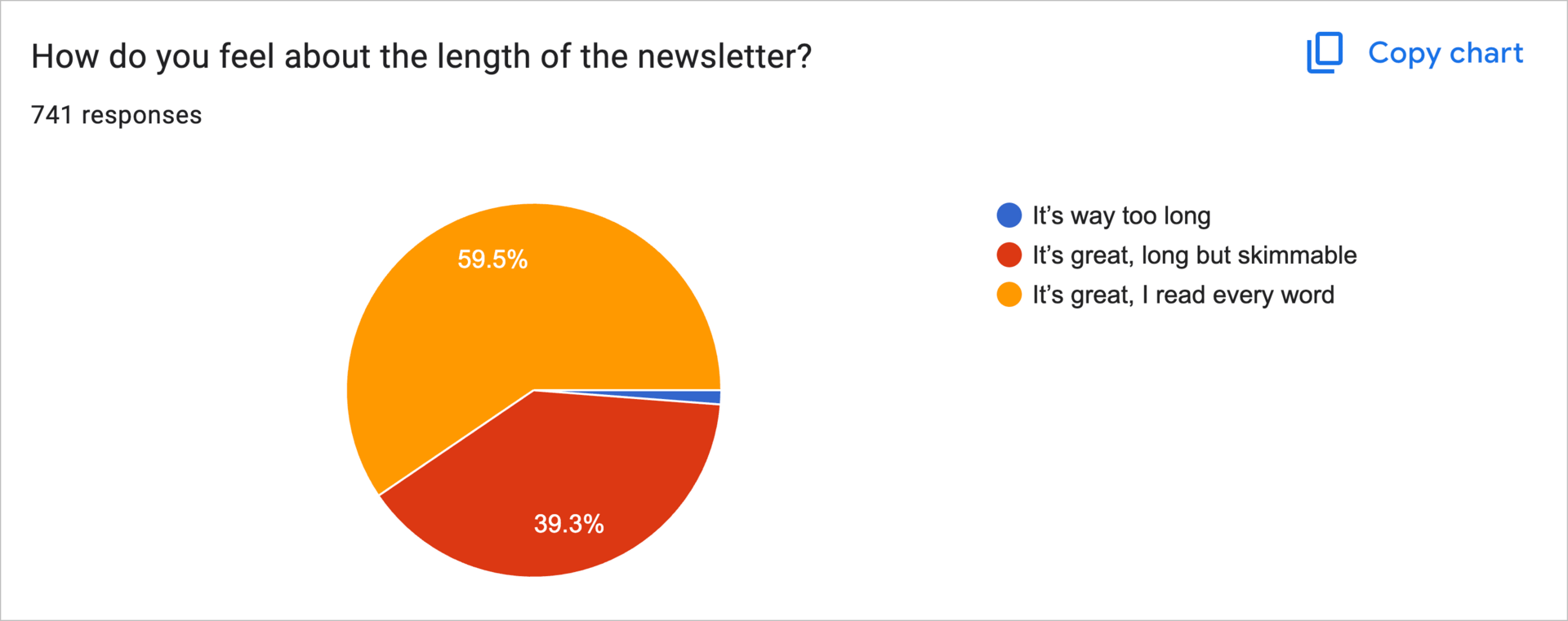
14. The stuff I get the most feedback on is barely about golf. I guess I figured this would be the case, but it’s definitely encouraging that it’s true. Rory at Augusta, Scottie on Ecclesiastics — none of that was about golf in the traditional sense. Or it barely was.
So when I write in my Twitter profile that I use golf to write about life, I think that resonates with the people who follow along, listen and read. It’s a community that cares about golf but cares more about things beyond golf. One I am very proud to be a part of.
15. Caring is undefeated. Ultimately, I’m convinced that most businesses fail or succeed based primarily on how much care their caretakers put in.
I included the following tweet in the first ever newsletter I sent out.
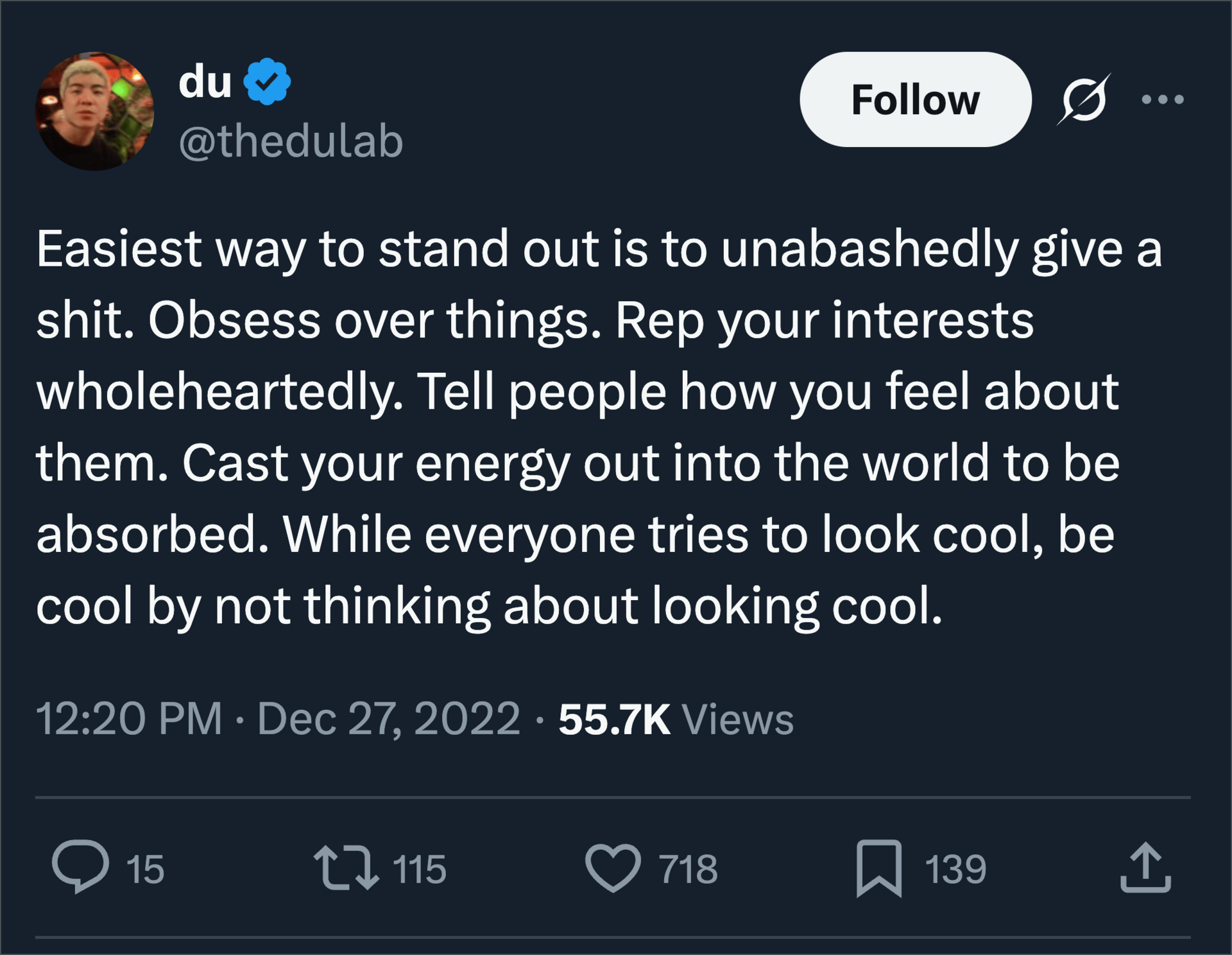
It’s still true. It’s more true now than it was back then.
Do you care? Do you enjoy the labor or just the fruits of it?
Enjoying the labor is a tremendous privilege, that is nicely summed up in this excellent interview by Austin Kleon with writer, Laura Lippman.
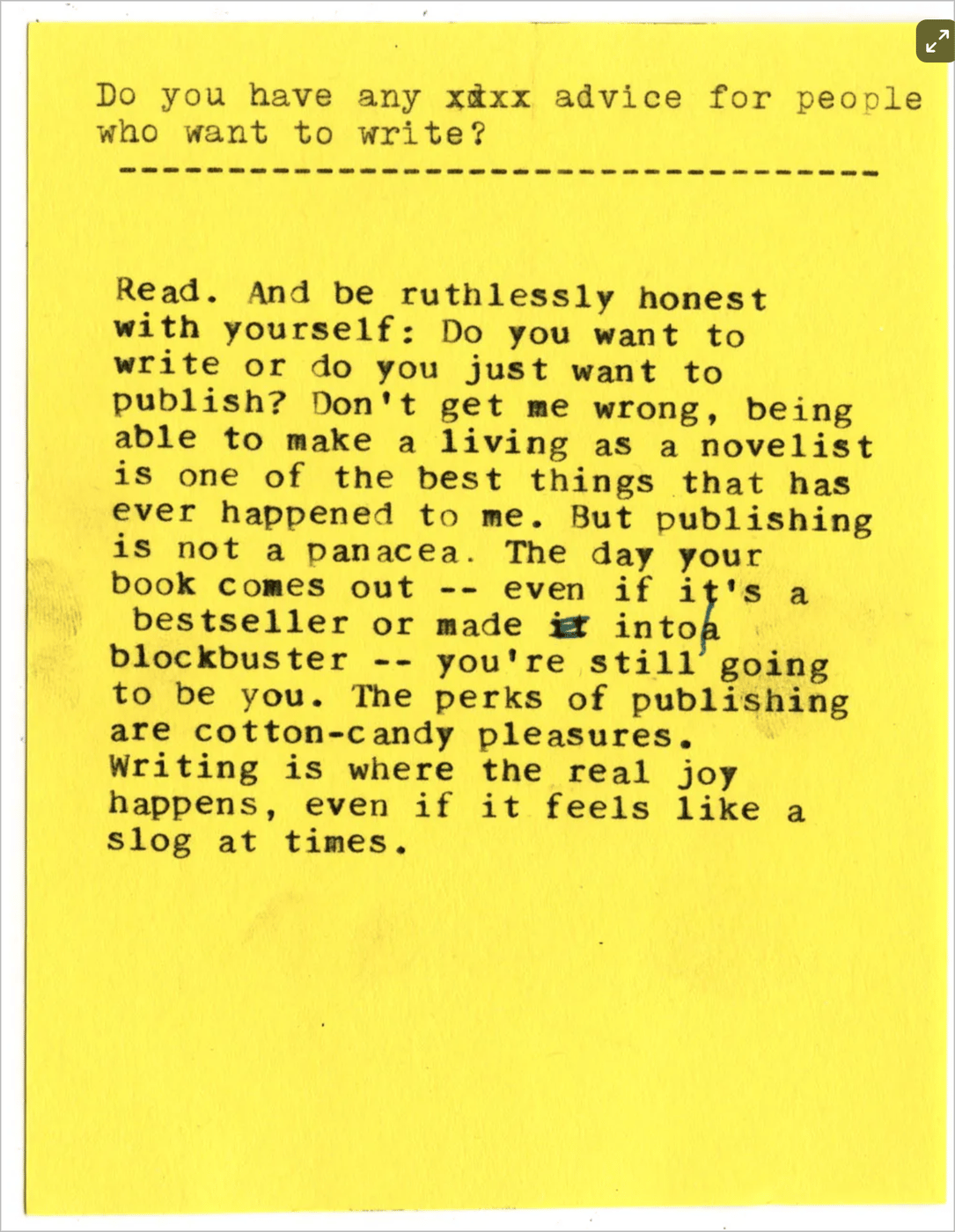
I don’t necessarily know why I care about all of this, nor do I necessarily understand why so many other people do either. Only that we all do care.
I care about the writing, care about The Open, care about how the Ryder Cup goes, care if you don’t like the font we use on our emails, care about how our logo looks on the last 1.5 seconds of our social clips.
I knew I wanted to do all of this.
I knew I wanted to have my own company and run my own business. I knew I wanted to make things for you to enjoy.
I’m surprised, however, that is has not only remained such a joy but that it has become even more of one over the last 500,000 words and illustrations.
Thank you, as always, for reading and following along.
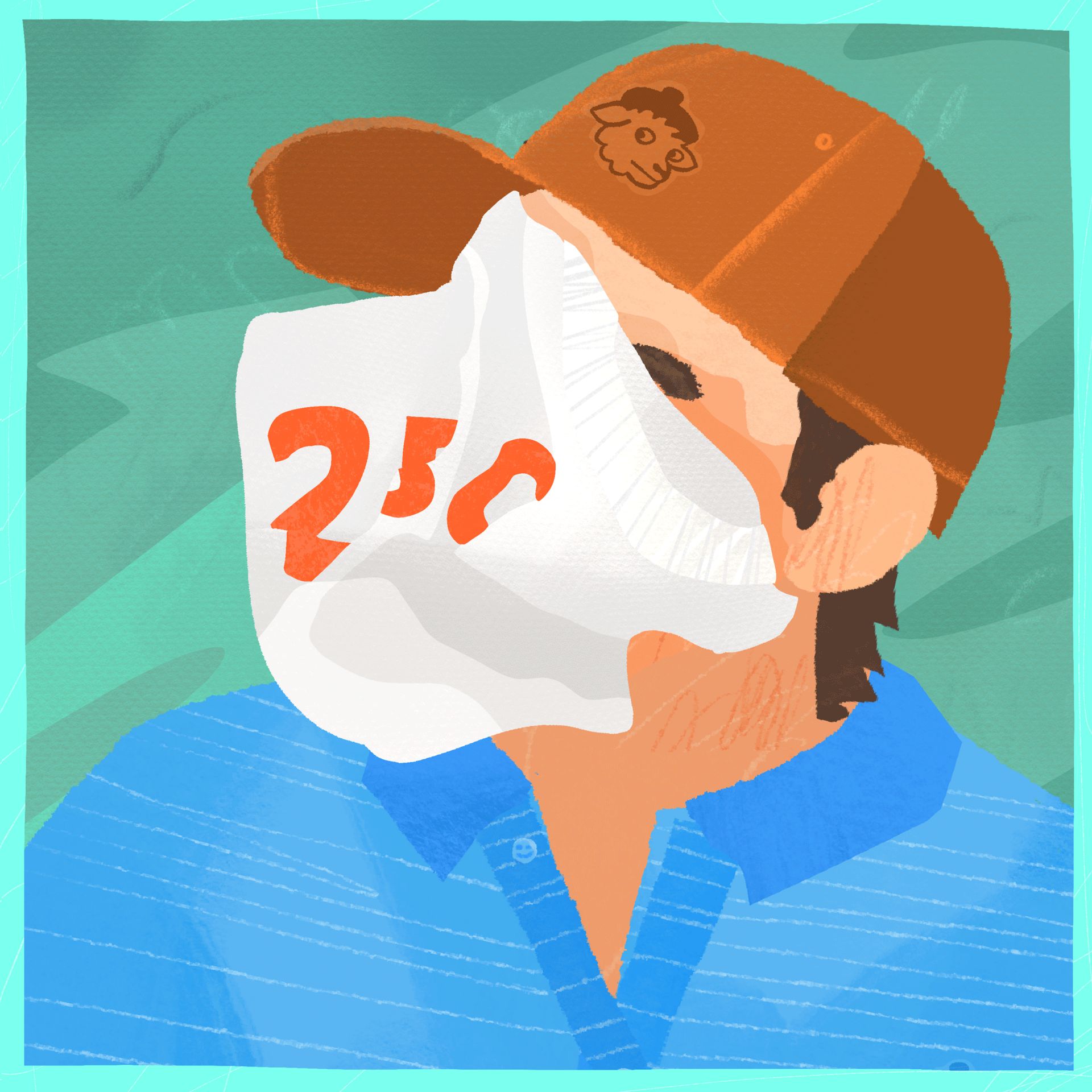
Issue No. 261 | October 10, 2025 | Read Online

Greetings!
Last week marked one year of Normal Sport as a full-time business. We haven’t run out of money (yet!), and we certainly haven’t run out of things to say and illustrate.
I have been reflecting not only on that first year but also on passing the 250 newsletter mark (roughly 500,000+ words since February 2023) and had a few thoughts I wanted to share with all of you about the journey.
Things I’ve loved. What I’ve dreaded. Some extraordinary moments. A bit of what I’ve learned.
This is work, I guess, but never has my life and my work been so intertwined. That can be a good thing — it has been an amazing thing for me — but it can also be a detrimental thing if I let it take over my mind and my heart and begin ignoring my kids because “I’m sorry, honey, but I just cannot stop thinking about the odd and even holes at Bethpage.”
But we’ll get to all that.
First!
Thank you to Seed Golf for sponsoring today’s newsletter. Seed has been with us since basically Day 1 of running this business full time, which has been exciting. Over that time we’ve gotten to know Seed founder Dean and learned from him how to run an authentic business in the golf world, which has been so helpful for us.
You don’t need to take it from me that you should check them out, either (although you should) because I got this email from a reader this week about his experience with Seed Golf.
Last thing, I ordered a box of Seed balls and really like them, so will for sure be ordering some more. Thanks again and I look forward to seeing what comes next for Normal Sport.
Andy H.
Thank you to Seed Golf for their partnership. You can get 20 percent off your next order by using this link.
OK, now onto the news.

1. To be completely honest, I’ve always hated the term “newsletter.” In the same way the word “golf” connotes a thing that is old and fussy and stodgy for many people, I think the word “newsletter” does the same.
Newsletters should be called “journal entries” or “longer tweets” or something like that.
I’ll never forget reading this from the godfather of paid newsletters, Ben Thompson of Stratechery fame. It is an idea that is very much my wheelhouse.
Stratechery has become in many respects a journal of my own attempts to understand technology specifically and the way in which it is changing every aspect of society broadly.
And, it turns, out, the business model is even better: instead of taking on the risk of writing a book with the hope of one-time payment from customers at the end, Stratechery subscribers fund that intellectual exploration directly and on an ongoing basis; all they ask is that I send them my journals of said exploration every day in email form.
Stratechery
That is almost exactly how I view Normal Sport: A journal of my own attempts to understand golf specifically and what it says about both us as individuals and the world more broadly.
2. I have perhaps mentioned this before, but I thought when I got into sportswriting, I would find the “ends of the parameters” (as Bryson noted in his pre-Masters press conference earlier this year). Instead, the opposite has happened.
I have been doing this for 13 years now, and I’ve never felt like I’ve had more to talk about. The rabbit hole, as it turns out, just keeps on going and going and going and I find the exploration of it to be endlessly fascinating. All of it. The data, the emotional nature of this sport, the history of it. I’m intrigued by it all.
I do not know why this is the case, but I am extremely glad that it is unquestionably the case.
[Jason here] “Ends of parameters” feels like a good place to jump in with my illustration notes. Every week, for the past year and a half, I dive into the illustrators pit totally unsure what will come up. Sometimes it goes well, often it goes sideways, but something always goes into the newsletter.
That rush to publish is the fun and the challenge of it. Just like how you can’t have an exhibition without art, you can’t have an illustrated newsletter without illustrations.
I like how these time lapses capture the searching for an image. They’re all made in a flurry, and only once they’re in the world am I able to reflect and think about what works, what doesn’t work, what can be reworked later.
Like how this illustration of hypnotized Chris Gotterup turned into the rowdy Bethpage crowd VR training for team Europe.
I hope you like a peek into how the illustration sausage is made.
3. [Kyle back] The flip side of this is that I have learned that I am a bad self-editor. I tend to write 2,200 words when 600 are needed.
The (perhaps apocryphal) Blaise Pascal quote often comes to my mind.
If I had more time, I would have written a shorter letter.
Blaise Pascal
I am working — laboring! — to edit down, to get tighter with what I’m saying. And while I find that I rarely speak for an inordinate amount of time, there is really no limit to how much I can (and want to) type, research, think and type some more. The good side to err on, I suppose, but a shortcoming nonetheless.
4. We are moving (back) toward campfires.
I have written about this a bit, but I was rattled by a conversation I had earlier this year with another writer who insisted that nobody is reading anymore and that society is moving toward a modern version of what it has been forever, which is just people telling stories around a campfire (in other words, podcasts).
This is part of the reason we recently launched our show, which I have been excited about and was even more confident about after reading this data in our 2025 survey.

That is pretty staggering to me — a newsletter writer! — even if I probably find myself agreeing with it in my own life with the way I interact with other media.
5. Nontraditional can work. My friend Sean Zak asked me to guest lecture on newsletters for his sports media class at Marquette this fall. In light of that, I was thinking about how no teacher in their right mind would advise someone to write or communicate the way I write and communicate.
It would not get me a job at a newspaper for most of the modern existence of newspapers. I would probably be laughed out of any 101-level journalism class.
I make jokes about reptile skull golf trophies. It’s all actually quite stupid.
But I find this to be a feature rather than a bug. I grew up in the Bill Simmons world where observing and theorizing were often (not always, but often) more intriguing than dull reports about why the manager pulled his starter at the end of the 5th.
And I think my style is probably as nontraditional as my methodology. I write like I talk. Full stop. Again, historically-speaking, no professor would approve this, but for some reason, it seems to … work?
Here’s Joan Didion on writing.
To shift the structure of a sentence alters the meaning of that sentence, as definitely and inflexibly as the position of a camera alters the meaning of the object photographed ...
The arrangement of the words matters, and the arrangement you want can be found in the picture in your mind ... The picture tells you how to arrange the words and the arrangement of the words tells you, or tells me, what's going on in the picture.
Joan Didion
This is how I put this newsletter together!
Also, me reading Joan Didion talking about hanging pictures in your mind.

6. [Jason here] My version of this is making portraits for our Q&A series, which was one of the most fun and challenging illustration exercises in the past year.
Fun to get to know characters in the golf world and challenging to do their characters justice in a portrait.
Here’s how I introduced that experience in Jeff Marsh’s ’GOLF is art’ 3.
Nobody wants to see a botched Ronaldo sculpture of their face for the sake of art. That’s a lot of pressure. Photography does a pretty good job of capturing reality, so instead, in my illustrations, I loosely loosely for the visual essence of the subject’s character and work. Easier said than done.
My process starts with a “this sucks”, then gets going when I think of Chet Baker’s line “let’s get lost”, and finally races ahead when the face starts to emerge like the “there you are” dinner scene in Hook when Robin Williams becomes Peter Pan.
Me - (GOLF is art 3)
7. [Kyle back] Here’s a weird one. I feel less exposed and like my career is more stable than I did two years ago when I worked for one of the biggest media companies in the world. Perhaps I am overly desirous of control. Or perhaps the ability to direct one’s future without it being directed by outside forces actually is more stable.
This is not to say that it has been a financial windfall. I am making half of what I used to make, but the two paths I see (old at CBS and new at Normal Sport) could not look more different. I thought this could be the case, but I wasn’t sure it would be.
I am delighted that it is.
8. To go along with this, I have realized that I am quite content if Normal Sport never becomes a $10 million business.
This might sound silly, but I had a conversation recently with Ethan Strauss on his show about how I either feel more content or less ambitious than before.
I simply want to make a baseline level of money for my family and to get to go create and do wonderful work alongside sponsors who help support it and a great audience who loves receiving it. Again, this may sound like a “duh, that’s just business” thing to you, but I did wonder if my ambition for more and bigger and grander would overtake my contentedness to do the thing that I have grown to love doing.
I am once again delighted to report that it has not.

No matter how big we get, it would still be cool to get t-shirt gun eventually.
9. Being on site at events matters for two reasons.
2025 Masters — So few people felt what I got to feel on that back nine on Sunday. The fog of history that enveloped those last nine holes was so richly experiential that it not only deeply informed what I wrote that afternoon but what I have written for the rest of Rory’s year.
2025 Ryder Cup — I was able to talk to various officials on the European side about ideas and theories that I have while everyone was congregated in one space and easily accessible. This is a unique type of reporting, I suppose, and it’s only available when you’re in attendance at these events.
So thank you for to the 1,012 of you who are Normal Club members, which provides us with the capital needed to travel like this.
[Jason here] Our daily newsletters during majors, more so than weekly newsletters, have a special energy to them (membership plug alert).
We’re locked into the golf and capturing the ups and downs of history as it’s happening, especially this year. For me, no illustration did that better than the Rory washing machine image which was innocent enough for the Round 3 newsletter and then really landed when I added his shot tracer and green jacket at 2:30 a.m. Amsterdam time for the Round 4 newsletter.
I love this illustration.
This post will continue below for Normal Club members and includes …
• A note on how I view AI.
• How our readers feel about newsletter length (surprising).
• And why caring is undefeated.
Normal Sport is supported by exactly 1,012 crazed individuals. By becoming a member, you will receive the following …
• A vote for trusted, independent media.
• The delight of helping us establish Normal Sport.
• 15% off to our pro shop.
• Access to all of our content (like the rest of this post).
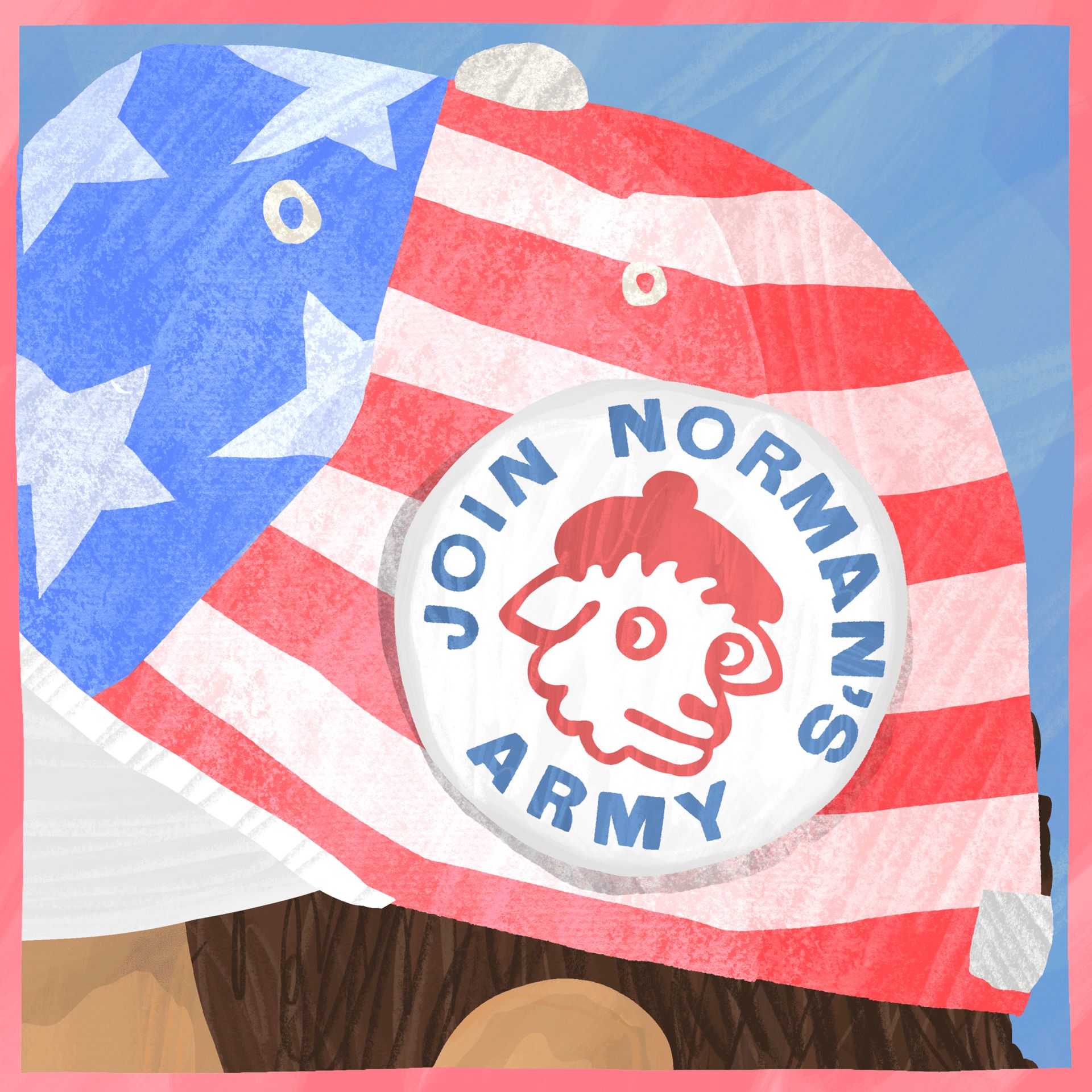










.svg)